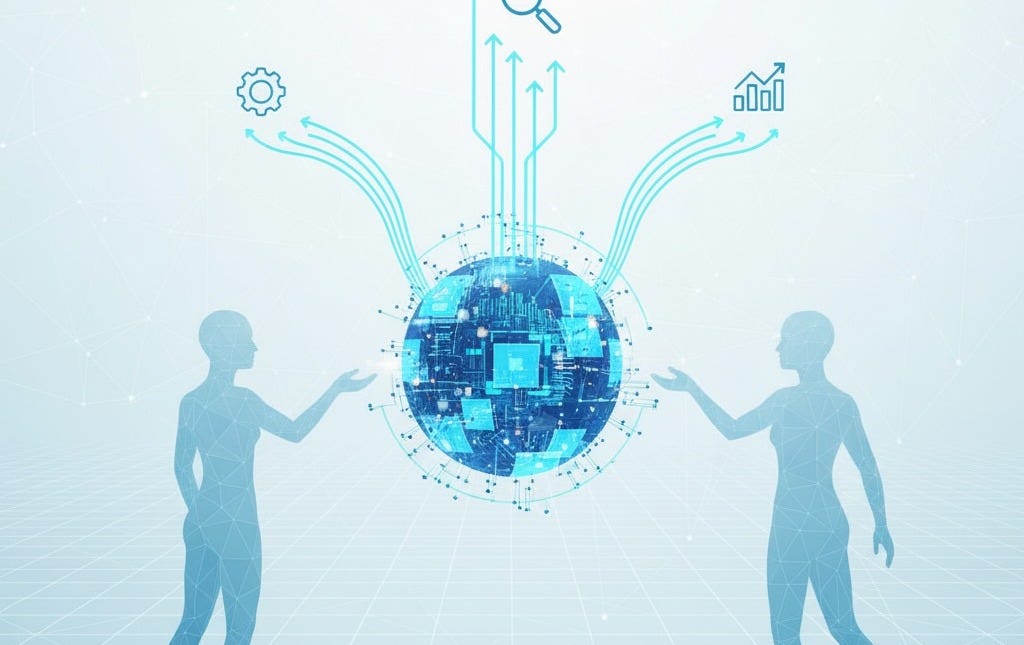Beyond the Bot: How AI Automation Unlocks Your Team's True Potential
Empowering Your Workforce: Augmentation, Not Replacement
This article was originally published on the Automata Partners site
Introduction
Throughout history, fears have arisen that innovations and automation would displace human jobs and purpose, yet the maximalist worst-case scenarios have consistently failed to materialize. In the 1970s, for example, widespread concern that the rise of ATMs would lead to mass layoffs of bank tellers ultimately proved unfounded. Instead, ATMs actually led to an increase in the number of bank tellers by lowering the cost to operate branches and shifting employee duties toward more valuable tasks. Time and again, technological progress has been shown to enhance human productivity and enable us to focus on higher-value labor. The advent of artificial intelligence is no different; widespread fear-mongering about the loss of opportunities and human purpose obscures the new doors it is opening. AI will not replace your team, but it will eliminate drudgework and tedious tasks, allowing them to focus on activities that drive real value.
The Hidden Cost of Drudge Work
Repetitive, low-value tasks deplete employees’ mental energy, eroding their creativity and engagement and leading to burnout. As individuals’ time becomes consumed with checking emails, answering routine questions for clients and coworkers, and copying and pasting data, their ability to focus on their core responsibilities diminishes. This also fosters a sense of listlessness and a lack of purpose in their work. As organizations grow, the proportion of time spent on meaningful work often decreases, replaced by more mundane tasks and increased communication with various management levels. This trend is evident in the rise of what are colloquially known as “bullshit jobs.” The time spent on such drudgery diminishes employees’ self-worth as they become aware of how much of their time is spent merely checking boxes for a faceless organization, rather than providing value or driving change.
This continuous drain of energy and time directly hinders employees’ ability to engage in strategic and fulfilling work. When mental bandwidth is constantly consumed by operational minutiae, there is little left for deep thinking, creative problem-solving, or long-term planning. The urgent often displaces the important, and strategic initiatives are either delayed or approached superficially due to a lack of dedicated focus. Employees may also experience a decline in job satisfaction, as the absence of meaningful contributions can lead to disengagement, making it even harder to invest fully in more complex, rewarding projects. Ultimately, the organization suffers from a lack of innovation and proactive development, as its most valuable asset, its human capital, is diverted from its true potential.
This dynamic is often exacerbated by the visibility of such low-value tasks. In many organizations, the act of participating in numerous meetings, sending frequent emails, and visibly responding to every request can create a perception of high productivity, even if the actual impact is minimal. Consider a scenario where a team member is consistently vocal in meetings, quick to reply to email chains, and outwardly engaged in various discussions, yet rarely delivers substantive, high-quality work. While their visible activity might be interpreted as diligence, it often overshadows the quiet, focused efforts of others who are heads-down, diligently working on complex, impactful projects. Unfortunately, this “performance charade” can sometimes lead to these outspoken but low-impact employees being promoted over those who consistently provide real value, simply because their superficial contributions are more readily observed and rewarded by management who is removed from the day to day operations.
AI as Your Digital Teammate
This is the core reason you’re reading this. AI offers employees a pathway out of the mundane and repetitive aspects of work today. Instead of being stuck performing time-consuming tasks like data entry, scheduling, and initial lead qualification, your team is freed for higher-level work. In essence, AI acts as a universal intern for every employee, handling the prep work so your team of experts can focus on execution. This allows them to shift their focus to ensuring data validity, reviewing their calendars with relevant notes for scheduled events, and engaging with leads they confidently know are valuable for the organization to pursue.
This shift not only significantly improves employees’ quality of life by reducing the burden of unfulfilling work but also directly enables them to expand the business’s bottom line. By redirecting human capital from rote tasks to strategic initiatives, companies can unlock new levels of productivity and innovation. Employees, freed from the digital treadmill, can dedicate their sharpened focus and creative energy to building stronger customer relationships, devising innovative solutions to complex problems, and engaging in proactive strategic planning that drives growth and competitive advantage. This augmentation allows teams to scale their impact without necessarily scaling headcount, transforming a perceived cost center into a powerful engine for revenue generation and sustainable expansion.
AI will be your digital teammate, ever present and eternally dedicated to enabling the team. In its role as a digital teammate, AI not only streamlines workflows by automating routine tasks but also enhances organizational transparency and accountability. By intelligently processing and organizing information, AI systems can provide real-time dashboards and reports that offer management clear insights into ongoing projects, individual contributions, and overall team progress. This eliminates the need for constant updates, status meetings, and “informational ping-pong” between different hierarchical levels, freeing up valuable time for strategic discussions rather than tactical reporting. Managers gain a comprehensive, data-driven view of operations, allowing them to make more informed decisions, identify bottlenecks proactively, and allocate resources more effectively, all without overburdening employees with redundant reporting tasks.
Unlocking High-Value Work
AI can gather and process performance metrics, sales figures, and project progress, thereby freeing managers from manual report generation and the time spent synthesizing information they’re expected to relay up the chain. Liberated from constant tactical reporting through AI automation, managers can invest more time in mentoring and developing their teams. This could manifest as personalized development plans, workshops, or simply fostering a sense of camaraderie and collaboration among coworkers. When managers have the space to focus on the more human aspects of their responsibilities, it will also reduce the often adversarial relationship between employees and their bosses. Rather than looking up the chain of command and seeing someone engaged in even more repetitive and “useless” tasks than themselves, employees will experience the benefits of management focused on guiding the path forward.
With routine customer inquiries handled by AI, employees can focus on the interpersonal and physical aspects of their jobs and client interactions. Teams can focus on complex customer issues, personalized outreach, building deeper, more meaningful relationships with customers. For example, instead of answering FAQs, customer service representatives can focus on proactively checking in with high-value clients or resolving intricate service issues, leading to increased customer satisfaction and loyalty.
The higher-value work opportunities available to employees will extend beyond interpersonal dynamics. No longer burdened by retrieving and disseminating information and mundane tasks, employees can focus their mental energy and time on brainstorming new products, optimizing processes, and developing novel solutions to business challenges. This is the work that human ingenuity and lived experience is invaluable to. AI enables the focus of an organization to be on the horizon and new lands ahead rather than the monotony of the path.
Conclusion: A More Efficient, Innovative, and Fulfilled Workforce
AI augmentation will lead to increased productivity, innovation, and more fulfilling work for employees. Empowering the workforce to focus on the work they were hired to do rather than going through the tedious motions that glue together the moments of actual productivity. Leading to reduced fatigue and burnout and an increased sense of purpose, accomplishment, and ownership for the work done. AI isn’t to replace your team, it isn’t to pass the burden onto someone else, it’s there to free up mental energy for the things that matter.
This moment in history is defined by two diametrically opposed ideas. A fear of the future and replacement of humanity in the work force. While simultaneously decrying modern work for its performativity and uselessness. AI offers an escape hatch from the drudgery that has come to define modern work. By embracing automation, we are not diminishing the human role; we are restoring it. We are clearing the path for our teams to do what they do best: connect, create, and drive the business forward in ways no algorithm ever could.









